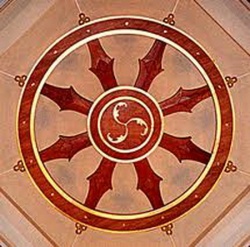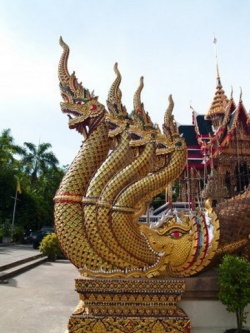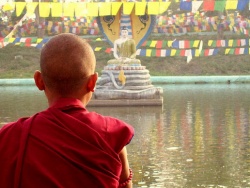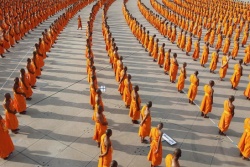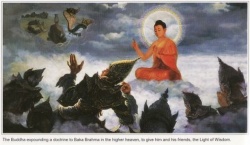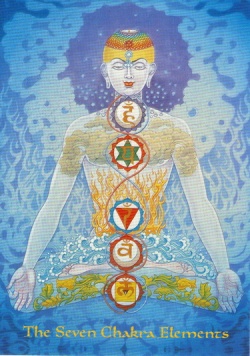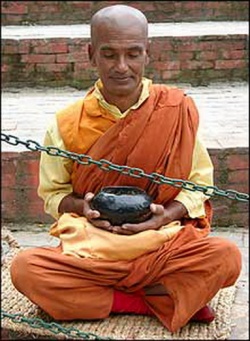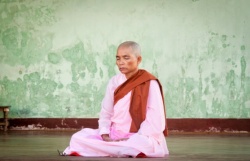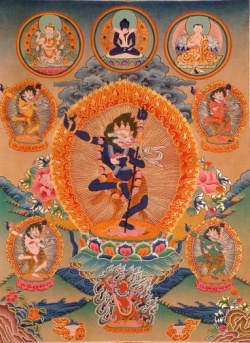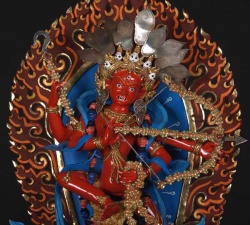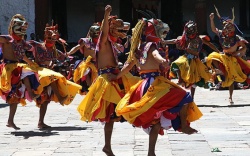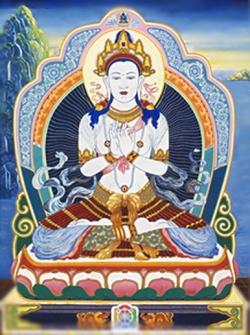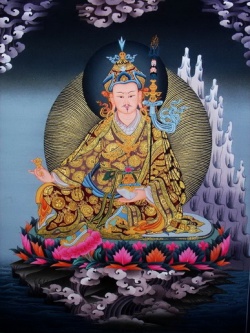Different Truths, One Reality
DIFFERENT TRUTHS, ONE REALITY
Distinct Approaches towards the Same Goal
By Lama Jigme Lhawang
Buddhist Philosophy, Research Paper
Kathmandu University, Center for Buddhist Studies
April 13, 2012
(The research presented here is not a definitive conclusion on the subject but a mere ‘inner exploration’ through the buddhist texts and possible thoughts that can come up when reflecting about the matter.)
The entire path of Buddhism can be understood through the framework of what is called the Two Truths – Relative Truth and Absolute Truth. The relative truth is what an ordinary person under confusion experiences. The absolute truth is what is experienced directly by those who realized the nature of all phenomena. Throughout the centuries after the passing away of Buddha different Buddhist scholars made the attempt to understand the Buddha’s teachings and tried to synthesize them in a more clear and direct way of comprehending the essence contained in it. Among those who attempt to clarify the Buddha’s teaching was Nāgārjuna who is considered the founding pillar of the Mādhyamaka view. Later, following his approach came Chandrakīrti who structured what came to be known in Tibetan Buddhism as the Prāsaṅgika Mādhyamaka tenet school. In the centuries that followed other distinct Buddhist teachers, both Tibetan and westerner scholars, deepened even more the understanding of what those Indian masters wrote given rise to other strands of interpretations. The Two Truths can be analyzed through the lens of different Indian non-Buddhist and Buddhist Tenet schools and their distinct Tibetan interpretations. However, a careful overview of three Prasaṅgika Mādhyamaka mainstreams views regarding the Two Truths, the ones propound by the Gelugpa master Je Tsonkhapa, the Nyingmapa master Ju Mipham Rinpoche, and the Drukpa master Gyalwang Je (the Second Gyalwang Drukpa Kunga Paljor) is what will be analyzed upon here.
In the Sūtra of the Meeting of Father and Son, Śhākyamuni Buddha taught about two different kinds of realities or what is experience as real for oneself, saying “Without having learned this from others, the knower of the world distinguished these two realities. The one is the seeming and the other the ultimate – there is no other third reality.”[i] Those two truths (skt. satyadvaya) are, in Sanskrit, the saṃvṛiti satya (lit. all-covered truth) and the paramārtha satya (lit. actual fact truth). Though they are often translated as “relative truth” and “absolute truth” or “seeming reality” and “ultimate reality,” those renditions convey only a partial semantic field of the meaning intended by the tradition from where they come from. Moreover, such conventions – relative and absolute – carry a vast range of use, meaning and interpretations in the western thought and philosophy that are not a direct and faithful interpretation of the original Sanskrit saṃvṛiti satya and paramārtha satya.
Gyalwang Je says that the mode of the two truths being different is as follows: “Actual Fact stands for [the Sanskrit) paramārtha where param (actual or genuine) is a synonymous for ‘best’ or ‘superior’. As for ārtha (fact) is a synonymous for ‘object’. Thus we have something like ‘superior object, the glory of complete purity’, which is reduced to ‘actual fact’ in reference to a ‘true situation’. ‘All-covered’ stands for [the Sanskrit) saṃvṛiti where saṃ is a synonymous to ‘completely so’, ‘truly so’ or ‘genuinely so’ and the whole word is ‘all-covered’ which is when appearances of confusion, appearances that have become other than the way things are, are labeled as true.”[ii]
The main analyzes presented in this paper is based in the Two Truths explanation given by the Indian Buddhist master Chandrakīrti:
“Since all things may be seen in a true or in a false mode;
One thing is apprehended as having a twin identity.
It is taught that whatever object seen in a true mode is suchness.
The false seen is the all-covered truth.”[iii]
According to Chandrakīrti’s verse the Sanskrit word satya indicates both meanings of what is real/existent (tib. yod pa) as opposed to unreal/non-existent (tib. med pa) mentioned in the verse as “things” (tib. dngos po) which are word-equivalents of existent (tib. yod pa). And of true/truth (tib. bden pa) mentioned by its word equivalent “genuine” (tib. yang dag) as opposed to false (tib. rdzun pa). What someone experiences in some specific way is a truth to that person, a reality that appears to be genuine and existent to one’s perception. Therefore, distinct people experience different kinds of truths or realities. Those realities are not true by themselves but are in direct dependence on one’s habitual tendencies and conceptual frameworks of mind. For instance, a pot and its functionality appear as such into a human conceptual sphere of experience. For an ant or even for a monkey a pot is experienced as a different thing with a distinct functionality even though it is the exact same material object.
Furthermore, following Chandrakīrti explanation, the term all-covered or totally-veiled (skt. saṃvṛiti, tib. kun rdzob), if explained by its etymology, takes the Sanskrit “saṃ” (tib. kun) as meaning “all” inner and outer things. When all those things (tib. dngos po kun) are apprehended through a deluded perceiver whose “eyes sight” is covered (tib. rdzob) by the cataracts of basic ignorance (skt. avidyā, tib. ma rig pa) the real fact (skt. paramārtha, tib. don dam), which is suchness (skt. tattvatā, tib. de kho nan yid), is obscured or veiled (skt. āvarṇa, tib. sgrib pa) and thus is seen in a false mode (tib. rdzun pa). Here, it is clear that Chandrakīrti relates the covered or concealed (tib. rdzob) aspect of mind with a false or untrue (tib. rdzun pa) seen object. The all-covering aspect of truth is in fact pervading the relation of both all (tib. kun) false seen things perceived by the covered (tib. rdzob) deluded mind which is the meaning of the Sanskrit saṃvṛiti and its Tibetan translation kun rdzob. Regarding the truth of suchness mentioned by Chandrakīrti, it is what was termed in Sanskrit paramārtha (tib. don dam). It is the authentic or actual (skt. param, tib. dam) fact, object, meaning or purpose (skt. ārtha, tib. don) which is the suchness seen by primordial knowing (skt. jñāna, tib. ye shes). Therefore, it does not exist objectively via its own identity and it cannot be apprehended by the conceptual mind but it is the authentic fact seen by the healthy eyes of those who realized the ultimate nature of reality. Whatever is an authentic object is by implication a fact. Hence, the Sanskrit paramārtha satya (tib. don dam bden pa) will be translated throughout this paper as “actual truth.” As for the Sanskrit saṃvṛiti satya, it is translated here as “fictional truth.” The semantic field meaning of the word “fiction” or “fictional” encompasses what is a product of someone’s imagination, a mental fabrication that is elaborated by the conceptual mind. It also means an untrue and false reality. Thus, the rendition “fictional truth” fits well as a translation for the Sanskrit saṃvṛiti satya. Both renditions – fictional and actual – resemble more closely the meaning of their original Sanskrit terms as well as are a perfect pair of antonymous corresponding to the primal distinction of the truths in their Sanskrit and Tibetan words.
It is stated in the scriptures that “fictional” and “actual” realities were already found in the Indian tradition before Buddha made use of them in his teachings. They were also widely used in many non-Buddhist schools after Buddha. The Sāṃkhya (tib. grangs can pa) tradition of Kapila, Arhat, Īshvara, and Patañjali for instance, assert “actual (skt. paramārtha) to be the self (skt. ātman, tib. bdag) and the fundamental nature (skt. mūlaprakṛti, tib. rtsa ba’i rang bzhin) or the primal principle (skt. prakṛti pradhāna, tib. rang bzhin can gyi gtso bo), in which the three qualities (skt. guna, tib yon tan) are in natural balance. The transformations of the primal principle are asserted to be fictional (skt. saṃvṛiti), deceptive occurrences (skt. dharmin, tib. chos can).”[iv] As for the followers of the Vedas such as the Guhyaka followers of god Brahmā, “ actual is the supreme, single self (skt. ātman, tib. bdag), its nature mere consciousness (skt. vijñāna, tib. rnam shes) that is all-pervasive like vast space. Although appearing as a multiplicity, it is not truly so. The appearance of individual partial entities – the world container, its contents of beings and so forth – are fictional, since as the self of mere conscious awareness (tib. bdag shes rig tsam), they are all the same.”[v] Others followers of the Vedas scriptures such as the Brāmaṇas, Vaiyākaraṇas, and Vedāntins “hold their particular personal deity of choice – Brahmā, Viṣhṇu, Īśhvara/Śhiva, etc – to be permanent and actual. All entities appear as magical emanations of them, and are considered to be unstable and deceptive,”[vi] therefore, fictional.
In the case of the Buddhist philosophical schools, interpreting the Buddha’s words, the ancient Abhidharma tradition developed an idea that the various building blocks of the body, mind and the world constitute what they called elemental phenomena (skt. dharma). For them, those elements are established as substantially real (skt. dravyasat) as well as ultimately real (skt. paramiirthasat). On the other hand, things that are constituted by those building blocks and can be reducible to these primary elements are considered to be real only in terms of designations (skt. prajiiaptisat), that is, they are established as only conventionally real (skt. vyavahiirasat). Moreover, in the Abhidharma tradition, a thing that exists substantially and is ultimately real, is posit to exist as well in terms of its own nature (skt. svabhāva) meaning independent of other causes and conditions, essentially there by itself and in itself.[vii] In this way, the Abhidharma tradition of those proponents of external entities (tib. dngos po smra ba) formulates the concept of the fictional truth as being “the coarse mental apprehension of which will be discarded by the destruction or exclusion of other.[viii] In other words, it is defined as “a phenomenon such that an awareness apprehending it is cancelled due to actually breaking it up or mentally separating it into its individual parts.”[ix] For instance, if a pot is broken with a hammer, the cognition apprehending that object as a pot is cancelled. Therefore, such a pot is posited as just a mental label designated conventionally. And the actual truth as a mental apprehension of “which cannot be discarded, being simply the partless instant of consciousness and the partless material particle.”[x] That is to say, “a phenomenon such that an awareness apprehending it is not cancelled due to actually breaking it up or mentally separating it into its individual parts”[xi] is an actual truth.
Distinctively, the Mahayanists belonging to the Cittamātra tenet school assert the fictional truth to be “that which appears as the duality of apprehender and apprehended, since it is merely imputed while not being existent.”[xii] For instance, a pot would be just an imputed designation pervaded by an illusion-like subject-object duality. As for the actual truth, the chittamātrins assert that it is “the basis for these appearances, the final dependent consciousness, the mere self-aware and self-cognizant mind. Empty of the outer apprehended and the [inner] apprehender, it is the thoroughly established nature.”[xiii]
In the perspective of Nāgārjuna, the great Indian pandita and siddha and forefather of the Mādhyamaka school, even though he agrees with the notion of two truths stating that “The Buddha’s teachings of the Dharma are based on two Truths”[xiv] he defines them as “a truth of worldly conventions and an ultimate truth,”[xv] disagreeing with the Abhidharma definition of those substantially existent building blocks to be bearing their own nature independently and therefore stated as ultimately real. For him, if anything exists ‘essentially’ it must be established without any dependence on another thing for its existence. A pot, for instance, does not exist in itself (skt. svabhāvataḥ) but rather in direct dependence on the particles that compose it not to mention other factors such as one’s own conceptual idea of what a pot is. Consequently, a pot just exists conventionally.[xvi] Therefore, for Nāgārjuna each and every phenomenon that appears to one’s mind bearing a distinctive feature (tib. khyad chos) must have the essential factor of dependence (tib. rtan pa) and inter-relation (tib. bral ba) in order to arise. Again, for instance, a pot without having dependence and inter-relation with other causes and conditions such as the quality of the mud, the quantity of water, the color, the apprehender’s cognitive framework, conceptual designations and so on would never take such a form and function.
Centuries later, clarifying the intended meaning of the two truths propounded by Śhākyamuni Buddha himself, and following the tradition of Nāgārjuna, the Indian scholar Chandrakīrti said that “Since all things may be seen in a true or in a false mode; One thing is apprehended as having a twin identity. It is taught that whatever object seen in a true mode is suchness. The false seen is the all-covered truth.”[xvii] Chandrakīrti added that this all-covered truth is such for the reason that it is perceived through the lens of basic ignorance (skt. avidyā) even though what this ignorance brings about appears as true[xviii] and that the object of the perceivers of actual truth is suchness (things as they are).[xix]
In Tibet, two great scholars – Ju Mipham and Je Tsongkhapa – propound distinct interpretations in presenting those two truths and in interpreting Chandrakīrti’s words. The Gelugpa master Tsongkhapa, for instance, in his interpretation of the definition of the two truths given above, defines them as: “[An object) found by a conventional valid cognizer perceiving a false object of knowledge” is a fictional truth. And actual truth as: “An object that is found by a reasoning consciousness perceiving, i.e., comprehending, the meaning of reality is suchness,” an actual truth. Ju Mipham, however, in his reading of Chandrakīrti’s verse defines the two truths as: the object perceived by authentic primordial wisdom is the actual truth, whereas the object of deluded perception is the fictional truth.[xx] It is interesting to note that Je Tsonkhapa differentiates the two truths by distinguishing a ‘valid cognizer’ apprehending a false object to be fictional truth and an object as it is ‘in itself’ to be actual truth. In Mipham’s distinct interpretation, what distinguishes the two truths is not the object apprehended but its apprehender that either ‘perceives’ reality through primordial wisdom or through a deluded consciousness.
Tsonkhapa’s interpretation leads to the idea of the existence of two different separate identities of an object – the existence of its fictional identity and the existence of its actual identity. He further explains, “What it is to be refuted is not the basis of negation (tib. dgag gzhi), i.e, the conventional phenomenon but the object of negation (tib. dgag bya), i.e. the true existence of that phenomenon. For him, pots “are not said to be empty of themselves but empty of true existence.”[xxi] This statement leads us to think that there is something else than the actual pot that is devoid of true existence and that there is a pot per se that is truly there. Thus, one concludes that for Tsonkhapa there is a ‘pot’ that exists ultimately and there is another ‘pot’ that is empty of true existence. Interesting to note that with this statement a single phenomenon turns to be divided in two distinct phenomena. The reason for that, he argues, is that one has to identify the conceptual mental factor which is the cause for ignorance, disturbing emotions and suffering, and eliminate it through negating its object. Such cause “is the grasping of an inherent nature or self, which he describes as that which is established by the way of its own nature objectively without being posited by the mind.”[xxii] In this way, Tsonkhapa argues that it is this grasping to inherent existence that obstructs the realization of emptiness and is the cause of disturbing emotions, and, therefore, requires removal, and not all kinds of conceptual elaborations such as the apprehension of a pot. For him, “because the grasping of conventional things such as a pot does not obstruct enlightenment, it is not necessary to negate the objects of such grasping.”[xxiii]
In Mipham Rinpoche’s understanding, if one says that a pot is not empty of pot but is empty of an extraneous attribute such as a true appearance of a pot, this is not emptiness, the ‘object’ of ultimate truth. For Mipham, “emptiness does not mean the absence of something from something else, as when one says that an eye [or a pot] is devoid of an inner agent or of the duality of the subject and object of perception.”[xxiv] This so called ‘absence of true existence’ can only refer either to the absence of the true existence of a pot or to the absence of true existence of something other than a pot. If one negates the true existence of something other than a pot, and one is left with a pot that is not empty of a pot, it follows that we have a pot that is truly existent. For Tsonkhapa, if conventional phenomena were completely empty they would not appear. This statement, in Mipham’s comprehension, means a separation of the two truths and a misunderstanding of the unity of appearance and emptiness.[xxv] Again, if a pot “is not empty according to its nature, it cannot be empty of true existence”[xxvi] for the reason that in that case its nature is not emptiness. For Mipham, when it is said in the scriptures ‘that a thing is empty of true existence’ it means that the thing does not exist truly. “It is the basis, the thing itself, that does not exist truly.”[xxvii]
In his commentary on Chandrakīrti’s Madhyamakāvatāra Ju Mipham states “the two truths are two distinct isolates of a single reality. Their one shared nature resides in the inseparability of appearance and emptiness.”[xxviii] For him, “what appears is empty. If emptiness were different from appearance, phenomena would no be empty.”[xxix] And “this nature, which is established as the indivisibility of appearance and emptiness,”[xxx]is the actual truth in itself. In other words, the appearance of a pot is just possible because it is inseparable of emptiness. The unity of a pot and its empty nature is its actual truth. The subjective non-recognition of this unity is what is named fictional truth. If appearance and the voidness of true existence, i.e., emptiness were two distinct things, it follows that the two truths then are differentiated. Appearance and emptiness would become two different things without a single nature. However, in that case, this position would deny inter-dependent reality, the very factor that allows things to appear and is the evidence of the empty nature of all phenomena, their voidness of inherent true existence.[xxxi] “Since a truly existent thing is never encountered, its so-called emptiness is actually the extreme of nothingness, in complete isolation from appearance, while the so-called appearance is just appearance by itself separated off from emptiness. This means that phenomena are not by their nature beyond existence and nonexistence, with the result that one is forced to rely on an emptiness that is extraneous to them.”[xxxii] This result seems to be an inevitable consequence of Tsonkhapa’s position where the appearance of a pot, being not empty, would fall in the extreme of a truly permanent existence amounting to eternalism and on the other hand emptiness would fall in the other extreme of nothingness amounting to the view of nihilism.[xxxiii] For Mipham, “if, while being without true existence, the pot is not itself empty, a wedge is driven between the lack of true existence and emptiness, and they do not mean the same thing.”[xxxiv] This assertion that appearances are not empty by their nature but are empty of an extraneous true existence goes against the very notion of inter-dependent arisen, the ultimate nature of all phenomena and the very essence of all the teachings of Buddha.
Instead of taking Tsonkhapa’s reason of the ‘deluded object’ as the cause for disturbing emotions Mipham argues that it is the apprehension of a pot as when one says ‘this is pot’ with all its attributes that give rise to disturbing emotions through the grasping of the pot as a phenomenon per se (tib. chos du ‘dzin pa). If one has grasping of outer phenomenon distinct from oneself it follows that one grasps also at an ‘apprehender’ of that phenomenon. Thus, the basic duality of a deluded consciousness with the grasping of an ‘I’ (tib. ngar ‘dzin) takes place as the foundation of suffering in cyclic existence.[xxxv]
Mipham also argues that the mere absence of true existence is apprehended by a dual discriminative knowledge (tib. shes rab). Since the ultimate reality or the actual truth is beyond the duality of all mental constructs, it follows that the mere knowledge of the absence of true existence apprehended by a correct discernment of phenomena cannot be established as actual. In other words, actual truth is only realized by non-conceptual gnosis (tib. rnam par mi rtog pa’i ye shes). The conceptual mind that apprehends the absolute negation of conventional existence is a mental event (tib. sems byung) whereas it is the non-conceptual gnosis without the duality of subject and object that realizes the ultimate nature of reality, the indivisibility of the two truths.[xxxvi] For Ju Mipham, “non-conceptual gnosis is marked by the dissolution of the duality of the two truths; it transcends the concepts of negation and negandum, subject and object, and appearance and emptiness”[xxxvii] whereas the mere discriminative apprehension of the two truths within the sphere of subject and object consists of conventional features that cannot reach the ultimate.
Finally, Gyalwang Je states that the distinction of the two truths is made from the standpoint of relying on the conventional words of scripture and reasoning and not on the actual meaning pointed out in the direct instructions of one’s teacher. Also, that its differentiation is made from the perspective of eliminating conceptual superimpositions externally and their inseparability from the cutting of the inner dualistic grasping. Moreover, he reveals that the whole notion of the existence of samsara and nirvana, bondage and freedom, things to be abandoned and things to be adopted, deluded afflictions and wisdom is made from the standpoint of the two truths being different. Once those two truths are realized in non-dual wisdom they are taken on the basis of freedom from the mental elaborations of establishment and negation, and of freedom from acceptance and rejection. Hence, the view from which they are not different but in actual fact inseparable is the very thing that ascertains the indivisibility of samsara as the pure field of nirvana, bondage as a natural expression of freedom, and deluded afflictions as a spontaneous display of primordial wisdom. The former differentiation of the two truths, Gyalwang Je says, follows the principle of the Sutra system and the latter follows the principle of the Mantra system.[xxxviii]
In conclusion, while Je Tsonkhapa understood the discernment of ultimate reality as a cognitive process consisting of epistemological features such as subjective and objective grasping, Ju Mipham perceived it as a non-dual experience beyond all mental elaborations of valid cognition. Within the non-conceptual primordial wisdom that realizes the ultimate valid cognition and epistemological definitions of reality do not arise. Consequently, it is this very experience of primordial wisdom that sees reality as it is in its ultimate mode of abiding that ceases completely ignorance, disturbing emotions and suffering and not the mere negation of the true existence of an objective phenomenon such as a pot, posit by Tsonkhapa. Tsonkhapa tries his best in conveying the two truths following the words presented and explained in the sutras weather Mipham make sure that the meaning implied on the words of the sutras is correctly interpreted. Gyalwang Je reveals that the very notion of samsara and nirvana, bondage and liberation, deluded afflictions and wisdom is groundless, and a mere dualistic and deluded mental projection. Also, that the view of the unity of the two truths is the very state of fruition that is taken as the path in the secret mantra vajrayana. Therefore, the conventional distinction of the two truths is epistemic not ontological. Phenomena in their side have no ontological nature. Phenomena in itself cannot obscure the ultimate but it is the epistemological subjective deluded cognition that conceals reality in its actual nature.
Bibliography
Brunnholzl, Karl. The Center of the Sunlit Sky: Madhyamaka in the Kagyu Tradition. New York: Snow Lion Publications, 2004.
Dunne, John. “Madhyamaka in India and Tibet.” In Oxford Handbook of World philosophy, edited by J. Garfield and W. Edelglass, 206-221. Oxford: Oxford University Press, 2011.
Duff, Tony. A Juggernaut of the Non-Dual View: Ultimate Teachings of the Second Drukchen Gyalwang Je. Kathmandu: Padma Karpo Translation commitee, 2011.
Gorampa on the Middle Way. Boston: Wisdom Publications, 2007.
Hopkins, Jeffrey. Maps of the Profound: Jam-yang-shay-ba’s Great Exposition of Buddhist and Non-Buddhist Views on the Nature of Reality. New York: Snow Lion Publications, 2003.
Mipham, Jamgon. Introduction to the Middle Way: Chandrakirti’s Madhyamakavatara with commentary by Jamgon Mipham. Boston: Shambhala Publications, 2002.
Newland, Guy. The Two Truths in the Mādhyamika Philosophy of the Ge-luk-ba Order of Tibetan Buddhism. New York: Snow Lion Publications, 1992.
Phuntsho, Karma. Mipham’s Dialectics and the Debates on Emptiness. New York: Routledge Curzon, 2005.
Thakchoe, Sonam. The Two Truths Debate: Tsongkhapa and Gorampa on the Middle Way. Boston: Wisdom Publications, 2007.
[i] Karl Brunnholzl, The Center of the Sunlit Sky: Madhyamaka in the Kagyu Tradition (New York: Snow Lion Publications, 2004), 72.
[ii] Tony Duff, A Juggernaut of the Non-Dual View: Ultimate Teachings of the Second Drukchen Gyalwang Je. (Kathmandu: Padma Karpo Translation Committee, 2011), 42.
[iii] Chandrakīrti, dbu ma la ‘jug pa.
[1] Mipham, ‘jam dbyangs rnam rgyal rgya mtsho, dbu ma rgyan gyi rnam bshad ‘jam dbyangs bla ma dgyes pa’I zhal lung, vol. 13. (Paro, Butão: Lama Ngodrup e Sherab Drimey, 1984), 1‑180.
[iv] Ibid.
[v] Ibid.
[vi] John Dunne, “Madhyamaka in India and Tibet,” in Oxford Handbook of World philosophy, ed. by J. Garfield and W. Edelglass (Oxford: Oxford University Press, 2011), 206-221.
[vii] Mipham, dbu ma rgyan gyi rnam bshad ‘jam dbyangs bla ma dgyes pa’I zhal lung, 1‑180.
[viii] Jeffrey Hopkins, Maps of the Profound: Jam-yang-shay-ba’s Great Exposition of Buddhist and Non-Buddhist Views on the Nature of Reality (New York: Snow Lion Publications, 2003), 233.
[ix] Mipham, dbu ma rgyan gyi rnam bshad ‘jam dbyangs bla ma dgyes pa’I zhal lung, 1‑180.
[x] Hopkins, Maps of the Profound, 234.
[xi] Mipham, dbu ma rgyan gyi rnam bshad ‘jam dbyangs bla ma dgyes pa’I zhal lung, 1‑180.
[xii] Ibid.
[xiii] Sonam Thakchoe, The Two Truths Debate: Tsongkhapa and Gorampa on the Middle Way (Boston: Wisdom Publications, 2007), 1.
[xiv] Thakchoe, The Two Truths Debate, 1.
[xv] Dunne, “Madhyamaka in India and Tibet, 207.
[xvi] Chandrakīrti, dbu ma la ‘jug pa.
[xvii] Mipham, Introduction to the Middle Way, 72.
[xviii] Guy Newland, The Two Truths in the Mādhyamika Philosophy of the Ge-luk-ba Order of Tibetan Buddhism (New York: Snow Lion Publications, 1992), 95.
[xix] Mipham, Introduction to the Middle Way, 192.
[xx] Ibid., 174.
[xxi] Karma Phuntsho, Mipham’s Dialectics and the Debates on Emptiness (Nova York:Routledge Curzon, 2005), 104.
[xxii] Phuntsho, Mipham’s Dialectics and the Debates on Emptiness, 104.
[xxiii] Mipham, Introduction to the Middle Way, 314.
[xxiv] Ibid., 176.
[xxv] Ibid.,177.
[xxvi] Ibid., 177.
[xvii] Ibid., 192.
[xxviii] Ibid., 192.
[xxix] Ibid., 192.
[xxx] Ibid., 194.
[xxxi] Ibid., 278.
[xxxii] Ibid., 278.
[xxxiii] Ibid., 278.
[xxxiv] Phuntsho, Mipham’s Dialectics and the Debates on Emptiness, 105.
[xxxv] Ibid., 192.
[xxxvi] Ibid., 192.
[xxxvii] Duff, A Juggernaut of the Non-Dual View.
